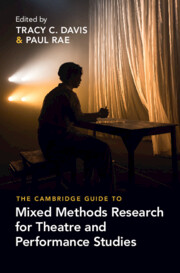Book contents
- The Cambridge Guide to Mixed Methods Research for Theatre and Performance Studies
- Reviews
- The Cambridge Guide to Mixed Methods Research for Theatre and Performance Studies
- Copyright page
- Contents
- Figures
- Tables
- Contributors
- Acknowledgements
- Introduction:
- Part I Planning
- Part II Doing
- Part III Interpreting
- Chapter 11 Methodologies Dialogue:
- Chapter 12 Non-linear Methodologies for Researching Early Modern Performance:
- Chapter 13 Taking Your Time:
- Chapter 14 Not Here for the Disciplines:
- Chapter 15 Methodologies Dialogue:
- Conclusion:
- Index
- References
Chapter 12 - Non-linear Methodologies for Researching Early Modern Performance:
The Case of the Canario
from Part III - Interpreting
Published online by Cambridge University Press: 01 February 2024
- The Cambridge Guide to Mixed Methods Research for Theatre and Performance Studies
- Reviews
- The Cambridge Guide to Mixed Methods Research for Theatre and Performance Studies
- Copyright page
- Contents
- Figures
- Tables
- Contributors
- Acknowledgements
- Introduction:
- Part I Planning
- Part II Doing
- Part III Interpreting
- Chapter 11 Methodologies Dialogue:
- Chapter 12 Non-linear Methodologies for Researching Early Modern Performance:
- Chapter 13 Taking Your Time:
- Chapter 14 Not Here for the Disciplines:
- Chapter 15 Methodologies Dialogue:
- Conclusion:
- Index
- References
Summary
Anke Charton takes the backstory of the canario, a baroque court dance, as an example to consider mixed methods in historiographic work. Marginalized knowledges, in particular, benefit from such an approach. Performance practices that have left few conventional traces behind can be explored more thoroughly if those traces are queried from different perspectives: reading archival sources against the grain, drawing on positionality, and engaging multiple temporal frameworks. The case of the canario illustrates the additional challenge – true for much of early modern Western theatre history – of working with a later, superimposed narrative that obscures an earlier, less-documented practice.
- Type
- Chapter
- Information
- Publisher: Cambridge University PressPrint publication year: 2024



